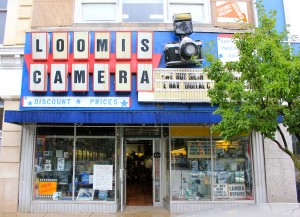Esther and Edwin Prentke

Edwin Prentke was born in early 1904 -- less
than three months following the Wright brothers flight at
Ed soon was pursuing his passion for cars.
Following graduation from
Ed's frustration at early cars being available only in black drove him to paint his car yellow. His affinity for yellow cars carried through to the purchase of his last car, a bright yellow 2003 Mustang convertible.
Esther was a very good typist, winning awards in 1923 and 1924.
When Ed graduated from Case in 1926, electrical engineering jobs were scarce. It was the era of the radio, and Ed's first work was door-to-door radio service. When his sweetheart Esther Green informed him that a prerequisite to marriage was that Ed have his own establishment, Ed rented a storefront for his business. They were married in 1933.
Here is Ed's business card:
and on the back he had written to Esther
Ed was an avid photographer and joined the Cleveland Photographic Society.
Ed took this photo of Charles and Anne Morrow Lindberg at the 1929 Cleveland Air Races just two years after the first non-stop trans-Atlantic flight.
.jpg)
In about 1944 the Prentkes bought a decades-old greeting card, office supply and stationery business in Elyria, Ohio from R. Ford Loomis and introduced cameras to the company’s product line. In 1950 he sold the company to Howard Foxman. Foxman operated the store until closing it in 2012. The Foxman story was chronicled in an article that appeared in an August 2012 issue of Cleveland Jewish News. Appreciation is extended to Sally and Larry Sears for noticing this article.

After selling Loomis Camera, the Prentkes established a similar business near University Circle in Cleveland. Eventually Prentke's, Inc. became dedicated to the sales and service of cameras and photographic equipment and supplies.
In addition to the photographic shop, Ed was
involved in other activities. (Accounts of this era included frequent references
to "Esther ran the store".) He taught electronics at both Case and
Esther played the piano and Ed played the organ. Ed was once part of a group of eleven organs and participated in a public performance.
They were a handsome couple.
Both Ed and Esther became avid sailors. They
bought a wooden 28' ketch around 1945, in which they sailed the
| |
|
|
By the mid fifties, Ed and Esther were thinking
of retirement. They sold the camera store, but soon realized that retirement
was not a good idea for them. Through a connection with physiatrist Charles
Long, M.D., both Ed and Esther secured employment at
Around this time, James Reswick, Ph.D. was
director of the
Among early projects were a device to limit the acceleration of powered wheelchairs, which otherwise started with a jerk because this was prior to electronic controls. A paraplegic patient in the hospital helped to design and build the first communication device for a man who had had a stroke. It was based on a discarded teletype machine.
Ed and his work were frequently featured in the local media.
Ed continued to contribute to the growth of PRC until 1979, when at the age of 75 he retired from PRC. (He continued his hospital employment.) PRC has continued to grow and has touched the lives of many tens of thousands of people with disabilities around the world.
Following a national search for a "Renaissance
tinkerer" in 1982,
"Your technological wizardry liberates the physically disabled
and your abiding faith in their total humanity restores their dignity."
Ed continued full time employment at the hospital until he was nearly 88. Here are some additional items:
1909 Hough Avenue house
1923 Radio License renewal Front and Back
ca. 1969 article from the JCRC newsletter on early technology for patients
1982 PRC Current Expressions article on the Brandeis award
1988 Case Alumnus magazine
ca. 1992 Ed's recollections
1929 car mentioned above
1997 Cleveland Plain Dealer article on Ed's "Teflon-coated retirement"
2001 Case Alumnus magazine
Some Prentke philosophy
Prentke wardrobe